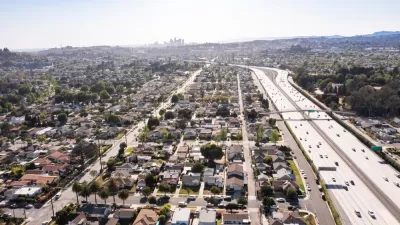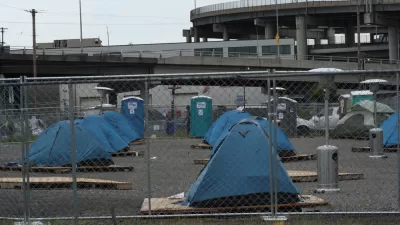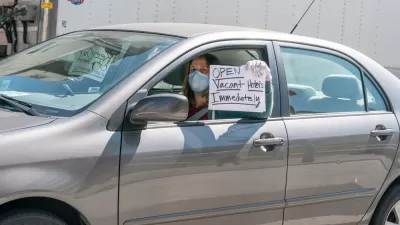Los Angeles is the nation's capital of both crowding and sprawl. A feature published by the Los Angeles Times provides the history of how the metropolis achieved this contradiction.

Whether it's fair nor not, Los Angeles is a symbol of the unfettered expansion of sprawl in the United States. So that should mean backyards and large, spacious homes for everyone, right?
Look beneath the surface, however, and the reality of the Los Angeles region is revealed as an overcrowded housing market—multiple families and households shoehorning into a housing supply not built to handle the demand of the nation's most populous county.
A feature article by Brittny Mejia, Liam Dillon, and Gabrielle Lamar Lemee, and Sandy Kambhampati for the Los Angeles Times looks past the symbolic region to reveal the consequences of the reality of Los Angeles, focusing on the consequences of overcrowded housing during the pandemic.
"At the heart of the storied metropolis of single-family-home sprawl, L.A. leaders created a cruel paradox: It is also the country’s most crowded place to live," According to the analysis reported here by the Los Angeles Times, Los Angeles County has more overcrowded housing than any other large county in the United States—a fact that has remained true for three decades.
During the pandemic, the region's hidden overcrowding in single-family homes had tragic consequences. The article places the blame for high covid death rates in low-income communities on the historic decisions made by planners and politicians: "This public health disaster was the inevitable consequence of more than a century of decisions that resulted in L.A. growing more like an endless suburb than a towering city."
- Related from Planetizen: Overcrowded Housing Connected to Coronavirus Infection (June 2020)
- Related from Planetizen: Los Angeles Mayor Blames COVID Outbreak on Density (January 2021)
- Related from Planetizen: The Link Between COVID-19 Deaths and Overcrowded Housing (July 2021)
To explain how Los Angeles achieved its paradox, the team of journalists "reviewed historical archives, oral histories and newspaper accounts, analyzed decades of U.S. census data and conducted dozens of interviews with academic experts, public officials, residents of cramped apartments and people whose family legacies in the region date back more than a century." They found a singular thread:
L.A.’s leaders could have addressed deplorable living conditions for the region’s poorest residents with more apartments, taller buildings and public housing. But they saw those ideas as anathema to the Southern California lifestyle they were creating. So in working-class neighborhoods, more and more people crammed into the existing housing stock, particularly as new streams of immigrants came from Mexico and Central America.
The entire history, along with damning judgments for 20th century planning and a warning for 21st century planning, can be read in the source article.
FULL STORY: L.A.’s love of sprawl made it America’s most overcrowded place. Poor people pay a deadly price

Alabama: Trump Terminates Settlements for Black Communities Harmed By Raw Sewage
Trump deemed the landmark civil rights agreement “illegal DEI and environmental justice policy.”

Study: Maui’s Plan to Convert Vacation Rentals to Long-Term Housing Could Cause Nearly $1 Billion Economic Loss
The plan would reduce visitor accommodation by 25% resulting in 1,900 jobs lost.

Planetizen Federal Action Tracker
A weekly monitor of how Trump’s orders and actions are impacting planners and planning in America.

Restoring Northern India’s Himalayan ‘Water Temples’
Thousands of centuries-old buildings protect the region’s natural springs and serve as community wells and gathering places.

Milwaukee to Double Bike Share Stations
Bublr Bikes, one of the nation’s most successful, will add 500 new e-bikes to its system.

DC Extends Application Window for Outdoor Dining Permits
District restaurants will have until the end of November to apply, but businesses with permits in rush hour parking lanes must end operations on July 31.
Urban Design for Planners 1: Software Tools
This six-course series explores essential urban design concepts using open source software and equips planners with the tools they need to participate fully in the urban design process.
Planning for Universal Design
Learn the tools for implementing Universal Design in planning regulations.
Caltrans
Smith Gee Studio
Institute for Housing and Urban Development Studies (IHS)
City of Grandview
Harvard GSD Executive Education
Toledo-Lucas County Plan Commissions
Salt Lake City
NYU Wagner Graduate School of Public Service





























